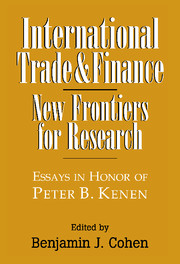Book contents
- Frontmatter
- Contents
- List of contributors
- Introduction
- 1 The practical theorist: Peter Kenen's contribution to international economics
- I International trade theory
- II International monetary theory
- III Applied policy analysis
- 9 Labor market adjustment and trade: Their interaction in the Triad
- 10 Do the G-3 countries coordinate monetary policy?
- 11 Fundamental determinants of Mexico's exchange-rate crisis of 1994
- 12 Devaluation cycles and adjustment costs
- 13 Payments problems in the Commonwealth of Independent States
- Index
12 - Devaluation cycles and adjustment costs
Published online by Cambridge University Press: 11 September 2009
- Frontmatter
- Contents
- List of contributors
- Introduction
- 1 The practical theorist: Peter Kenen's contribution to international economics
- I International trade theory
- II International monetary theory
- III Applied policy analysis
- 9 Labor market adjustment and trade: Their interaction in the Triad
- 10 Do the G-3 countries coordinate monetary policy?
- 11 Fundamental determinants of Mexico's exchange-rate crisis of 1994
- 12 Devaluation cycles and adjustment costs
- 13 Payments problems in the Commonwealth of Independent States
- Index
Summary
Introduction
Peter Kenen has been an important contributor to the debate on the appropriate exchange-rate policy for a single country. Some of his earliest work focused on the role of structural characteristics in influencing this choice. In recent years, he has helped shape the debate on the costs and benefits of moving to a common currency in Europe. This essay focuses on the decision to make an adjustment in the fixed exchange rate, given that a country has already made the decision to have a fixed exchange-rate regime. It draws on insights and themes in Kenen's own work to detect whether some of the economic factors that influence the choice of exchange-rate regime might influence the size and timing of devaluations as well.
Exchange-rate pegs do not last forever. A developing country often pegs its exchange rate to a single currency, such as the U.S. dollar, even though it faces a higher inflation rate than the country to which it is pegged. Eventually a growing real exchange-rate misalignment drives the cost of sticking with the peg above the cost of reneging. A devaluation occurs and the process begins anew. The purpose of this essay is to learn more about devaluation cycles by studying the costs associated with abandoning a peg.
Models of collapsing fixed exchange rates often assume that the policymaker bears a fixed cost of taking action and devaluing the currency.
- Type
- Chapter
- Information
- International Trade and FinanceNew Frontiers for Research, pp. 339 - 360Publisher: Cambridge University PressPrint publication year: 1997
- 1
- Cited by



